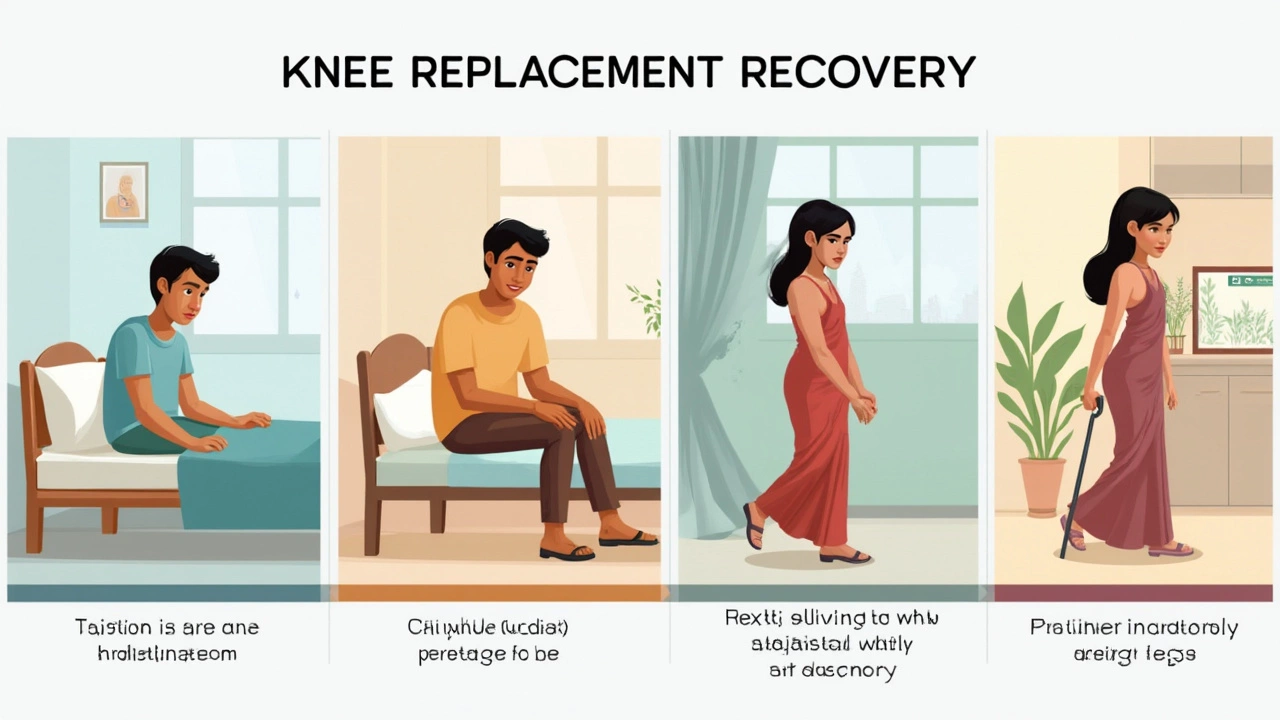If you just had knee replacement surgery, you’re probably wondering how much time you’ll actually be stuck in bed. Some folks expect weeks of bed rest—others think they’ll be out for a walk in no time. The truth? It’s not as black and white as you’d expect.
Most people are surprised to hear that you don’t actually need to be in bed for very long. The typical patient spends a day or two lying down after surgery, but doctors want you moving as soon as possible. This isn’t just to toughen you up; it’s actually safer for your new knee and helps prevent blood clots. The goal is to get you sitting up, standing, and taking a few steps—sometimes even the same day of surgery if you’re feeling up to it.
But don’t rush it and try to run a marathon on day one. Knowing exactly when to push yourself (and when to take it easy) can help you heal better and avoid hurting your new joint. Read on to get honest info about the real amount of bed rest you’ll need and what actually helps you recover after knee replacement.
- What Happens Right After Surgery
- The First Days: How Much Bed Rest Is Enough?
- When Can You Get Moving—and Why It Matters
- Tips to Make Bed Rest Easier
- Common Pitfalls to Avoid During Recovery
What Happens Right After Surgery
So, you’ve just come out of knee replacement surgery. You’ll wake up in the recovery room, feeling a bit groggy from the anesthesia. Nurses will be right there checking your blood pressure, oxygen levels, and how you’re feeling. It’s pretty normal to feel a little pain or tightness in your leg, but they’ll give you pain meds to help with that.
Your medical team will keep a close watch on your new knee and make sure there’s no unusual swelling or bleeding. They’ll check the bandage and watch out for issues like blood clots or infection. Nobody wants a surprise after surgery, so these checks are a big deal. If you have a urinary catheter or IV hooked up, don’t stress—it’s just temporary to help you move less while you’re waking up.
A lot of people think you’ll be flat on your back for days, but that’s not usually how things go. In fact, physical therapists may visit within a few hours after you wake up. Their goal? Get you moving, even if it’s just wiggling your toes or slowly bending your knee. Short, gentle movements boost blood flow and lower your chances of complications.
- Your leg might be in a machine that gently bends and straightens your knee (this is called a CPM machine in some hospitals), but not everyone gets this anymore—it depends on the latest research and your doctor’s preferences.
- You’ll probably have boots or sleeves on your legs that inflate and deflate. These keep your blood moving and help prevent clots from forming.
- Ice packs are common to keep swelling under control. Don’t be surprised if you’re told to keep your knee raised on pillows, too.
If you’re feeling alert and steady, don’t be shocked if you get out of bed—with help from nurses or therapists—within the same day. The whole point is to avoid too much bed rest, which can actually slow healing.
The First Days: How Much Bed Rest Is Enough?
After knee replacement surgery, the idea of bed rest can sound relaxing, but you actually won’t spend all your time flat on your back. In the first 24-48 hours, you do need to take it easy, but doctors and physical therapists almost always want you up and moving sooner than you think. Hospital teams today get most patients out of bed to sit or even stand, usually on the first day post-op.
Staying in bed too long can actually cause more problems than it solves. You’re at a higher risk for things like blood clots, pneumonia, and muscle loss if you stay completely still for days. Hospitals try to strike a balance between letting your anesthesia wear off, keeping pain under control, and starting the slow road to independence.
What does a typical routine look like in the early days? Here’s a real breakdown:
| Day After Surgery | Bed Rest Expectation | Activity Level |
|---|---|---|
| Day 0 (surgery) | Mostly in bed; legs elevated; monitored closely. | Maybe sitting up, with breathing and ankle exercises. |
| Day 1 | Short periods in bed, usually after exercises and meals. | Out of bed with help, possibly taking first steps with support. |
| Day 2 | Less time in bed; rest only when tired or after activity. | Walking a short distance; can often get to bathroom. |
Here’s what actually happens in those first days:
- The nurse or physical therapist checks on you several times a day to help you bend and move your knee.
- You might use a walker or crutches the first time you get up. Most people stand and walk (with a helper) the day after surgery.
- Being upright for a few minutes, a few times per day, usually starts right away—bed rest is broken up with these short sessions.
- You’ll still want your foot up and ice packs nearby when you rest in bed, as this helps control swelling.
If you’re worried about pain when you get up, don’t stress. The hospital will give you pain medicine to make those first moves possible. And if your head spins the first time, that’s pretty common—just let the staff know.
So, to sum up, you actually spend less time on strict bed rest than most people expect. The first 1-2 days are about finding your balance between moving around and resting enough to heal. After that, activity goes up and bed rest goes way down. The bed rest period is short because the faster you start moving safely, the better your recovery will usually be.

When Can You Get Moving—and Why It Matters
It might sound wild, but after a knee replacement, you’re usually encouraged to get moving almost right away. For a lot of patients, the first steps happen within 24 hours of surgery. Hospitals don’t want you staying in bed for days because it actually makes things harder—the longer you stay still, the stiffer your new knee gets and the greater your risk for things like blood clots or muscle weakness.
Your physical therapist or nurse will guide you through those first movements. Don’t worry, you’re not expected to run laps. You’ll do small things like standing at your bedside, taking a few steps with a walker, or practicing simple exercises to wake up your leg muscles. For most people, this starts on the same day as the operation or the very next morning.
So why does early movement matter after a knee replacement? Here’s what’s really at stake:
- Moving your leg helps boost blood flow, which lowers your chances of getting dangerous blood clots.
- It helps keep your joint from getting stiff, which makes it easier to get all your mobility back.
- Early movement fights off muscle loss and speeds up your healing, so you can leave the hospital sooner.
- You’re more likely to have less pain and fewer complications if you follow the rehab plan and get moving when told.
Don’t panic—this doesn’t mean you should be stubborn and try to walk around the house without help. Always follow your therapist’s instructions. If you’re worried the pain will be too much, there are usually meds to help you stay comfortable while you take those first steps.
By the second or third day after surgery, most people can walk short distances with help. Some clinics use a team approach where you’ll see nurses, therapists, and even social workers, all making sure you’re up and on track. By the end of the first week, many people are able to walk longer distances using a walker or crutches at home. The trick is to listen to your body—push a little, but don’t go overboard.
Tips to Make Bed Rest Easier
Nobody loves lying around after surgery, but there are ways to make your post-op time smoother and less frustrating. A few smart moves can help you stay comfortable, reduce pain, and handle the days when you’re mostly in bed after knee replacement.
First, set up your bed rest space before surgery if you can. Keep your phone, TV remote, water bottle, medications, and snacks within easy reach. It's a pain to call for help every five minutes, so make sure the stuff you use most is close by. One small but life-saving tip: get a grabber tool, so you aren't straining or risking a fall trying to pick things up from the floor.
Swelling and pain after knee surgery are pretty much a given, but you can keep them under control by following a few basics:
- Keep your operated leg elevated on pillows—at or just above heart level. Never put pillows directly under your knee (always under the calf or ankle instead).
- Use ice packs for 20 minutes every couple of hours to help with swelling. Have a towel between your skin and the cold pack to avoid frostbite.
- Take your prescribed pain meds as directed and don’t wait until you’re in agony. It’s much harder to chase pain than to prevent it.
Boredom can be just as tough as the pain. Have books, puzzles, or something to binge-watch ready. Many people find audio books perfect since you can listen with your eyes closed if you’re feeling tired.
If you’re worried about getting stiff or risking blood clots, doctors recommend moving your toes and ankles often, even while lying down. This keeps your blood flowing and helps battle stiffness early.
Don’t be shy about asking for help. Whether it’s for a snack, a pillow adjustment, or just some quick company, you’ll heal faster if you aren’t trying to tough it out solo. And remember, a little discomfort is totally normal—just keep an eye out for sudden, sharp pain or redness in your leg, and call your doctor if you notice anything strange.
Stick to these basic tips and your bed rest days after knee replacement will go by a lot smoother. It might not be fun, but you’ll save yourself a ton of trouble by prepping and listening to your body.

Common Pitfalls to Avoid During Recovery
There are a few mistakes that can seriously slow down your healing after knee replacement. Knowing what to skip is just as important as what you actually do. Here’s what lands folks in trouble more often than you’d think.
- Staying in bed too long: It sounds like resting longer would help, but too much “bed rest” can mess with your blood flow and make your muscles stiff. Doctors and physical therapists agree: try to get up—at least for a few steps—even within the first 24 hours after surgery.
- Skipping your pain meds: Some people tough it out but end up so sore they can’t move or do therapy. Take your pain killers as directed so you can get moving safely and stick with your exercises.
- Not doing your exercises: Physical therapy feels boring or even tough some days. But slacking off can make your knee stiff, which means more pain and slower progress. Most rehab programs include bending, stretching, and strength-building moves you need to do daily.
- Pushing too hard, too fast: On the flip side, trying to walk without a walker or doing squats too early is risky. Go at the pace your therapist sets for you, even if you feel good.
- Forgetting about swelling: Swelling makes your knee stiff and uncomfortable. Ice, elevation, and sometimes a little gentle compression will keep it under control. Don’t ignore swelling, especially in those first weeks.
- Not watching for infection: Pay attention to redness, pus, or fever. Reach out to your doctor if anything seems off. An infection can turn a simple recovery into a long hospital stay.
If you want a smoother recovery, focus on steady progress—not quick fixes. Listen to your team, do your therapy, and keep an eye on how your knee feels day-to-day. That’s how you can make the most out of your new knee and avoid the usual potholes that trip people up after knee replacement.
